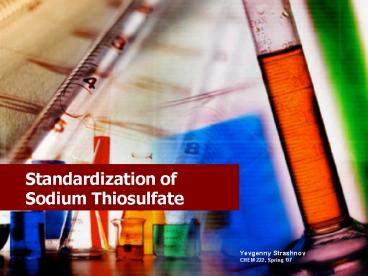Standardization of Sodium Thiosulfate
1 / 18
Title: Standardization of Sodium Thiosulfate
1
Standardization of Sodium Thiosulfate
- Yevgenny Strashnov
- CHEM 222, Spring 07
2
Introduction
- Sodium Thiosulfate (Na2S2O3) is used in Iodometry
to quantify the amount of iodine in solution, in
the form of Triiodide (I3-) - Since Sodium Thiosulfate is rarely/never
available as a primary standard, Na2S2O3
solutions must be standardized between
preparation and use - To standardize an Na2S2O3 solution, KIO3 is
usually employed as the primary standard
3
Stoichiometry
Two chemical equilibrium equations are involved
in the process
- IO3- 8I- 6H ? 3I3- 3H2O
- I3- 2S2O3 2- ? 3I- S4O6 2-
4
Preparation of (unstandardized) Sodium
Thiosulfate Soln.
The first step is to prepare the
unstandardized Sodium Thiosulfate solution We
do this by dissolving approximately 25g of
Na2S2O35H2O, and .1g of Na2CO3 in 1L of freshly
boiled dH2O. Addition of Sodium Carbonate
serves to buffer the pH at the optimal level for
stability. The boiling expels CO2, which can
make the solution acidic and promote unwanted
side reactions.
5
Preparation of Primary Standard
The primary standard (KIO3) is accurately
weighed, dissolved in dH2O, and chemically
treated to obtain I3- in solution, according to
Eq. (1)
- IO3- 8I- 6H ? 3I3- 3H2O
6
Preparation of Primary Standard
The primary standard (KIO3) is accurately
weighed, dissolved in dH2O, and chemically
treated to obtain I3- in solution, according to
Eq. (1)
- IO3- 8I- 6H ? 3I3- 3H2O
A slight excess of I- is supplied by dissolving
solid KI
7
Preparation of Primary Standard
The primary standard (KIO3) is accurately
weighed, dissolved in dH2O, and chemically
treated to obtain I3- in solution, according to
Eq. (1)
- IO3- 8I- 6H ? 3I3- 3H2O
The H can be supplied by adding a non-reactive
acid, such as H2SO4
A slight excess of I- is supplied by dissolving
solid KI
8
Preparation of Primary Standard
The primary standard (KIO3) is accurately
weighed, dissolved in dH2O, and chemically
treated to obtain I3- in solution, according to
Eq. (1)
- IO3- 8I- 6H ? 3I3- 3H2O
The H can be supplied by adding a non-reactive
acid, such as H2SO4
A slight excess of I- is supplied by dissolving
solid KI
In this manner, 3 moles of I3- can be obtained in
the solution for every mole of KIO3 dissolved
9
Standardization of Sodium Thiosulfate Solution
The standardization of Na2S2O3 occurs according
to Eq. (2)
(2) I3- 2S2O3 2- ? 3I- S4O6 2-
10
Standardization of Sodium Thiosulfate Solution
The standardization of Na2S2O3 occurs according
to Eq. (2)
(2) I3- 2S2O3 2- ? 3I- S4O6 2-
An exact amount of the treated primary standard
soln. is placed in an Erlenmeyer flask
11
Standardization of Sodium Thiosulfate Solution
The standardization of Na2S2O3 occurs according
to Eq. (2)
(2) I3- 2S2O3 2- ? 3I- S4O6 2-
An exact amount of the treated primary standard
soln. is placed in an Erlenmeyer flask
The unstandardized thiosulfate soln. is placed in
the buret
12
Standardization of Sodium Thiosulfate Solution
The standardization of Na2S2O3 occurs according
to Eq. (2)
(2) I3- 2S2O3 2- ? 3I- S4O6 2-
Starch indicator is used to accentuate the
endpoint
An exact amount of the treated primary standard
soln. is placed in an Erlenmeyer flask
The unstandardized thiosulfate soln. is placed in
the buret
13
Standardization of Sodium Thiosulfate Solution
The standardization of Na2S2O3 occurs according
to Eq. (2)
(2) I3- 2S2O3 2- ? 3I- S4O6 2-
Starch indicator is used to accentuate the
endpoint
An exact amount of the treated primary standard
soln. is placed in an Erlenmeyer flask
The unstandardized thiosulfate soln. is placed in
the buret
Thus, 2 moles of S2O3 2- are required to
neutralize each mole of I3-
14
Sample Calculations
- 1. Obtain exact molarity of primary std.
- (1.000g / 214.00g/mol) / 500.0mL
9.346E-6 mol/mL - 2. Obtain average equivalence volume of Na2S2O3
(for 50.0 - mL aliquots of primary std.)
- (1/3)(40.03 40.07 40.05)mL 40.05
mL - 3. Determine how many moles of Na2S2O3 must be in
this average volume as follows - 50.0mL(9.346E-6 mol IO3-/mL)(3mol
I3-/mol IO3-) - (2mol S2O3 2-/mol I3-)
2.80E-3 mol S2O3 2- - 4. Finally, calculate the molarity of the (now
standardized) Na2S2O3 soln - (2.80E-3 mol S2O3 2- / 40.05
mL)(1000mL/1L) -
.0700 M
15
Pop Quiz !!! )
- 1. What ion does S2O3 2- (the thiosulfate ion
that comes from Na2S2O3) react with during
standardization? What is the stoichiometric
ratio?
16
Pop Quiz !!! )
- 1. What ion does S2O3 2- (the thiosulfate ion
that comes from Na2S2O3) react with during
standardization? What is the stoichiometric
ratio? - A S2O3 2- reacts with I3- in a 21 ratio.
17
Pop Quiz !!! )
- 1. What ion does S2O3 2- (the thiosulfate ion
that comes from Na2S2O3) react with during
standardization? What is the stoichiometric
ratio? - A S2O3 2- reacts with I3- in a 21 ratio.
- 2. How is the I3- ion obtained from our primary
standard (KIO3)? In what ratio?
18
Pop Quiz !!! )
- 1. What ion does S2O3 2- (the thiosulfate ion
that comes from Na2S2O3) react with during
standardization? What is the stoichiometric
ratio? - A S2O3 2- reacts with I3- in a 21 ratio.
- 2. How is the I3- ion obtained from our primary
standard (KIO3)? In what ratio? - A The I3- ion is obtained by reacting IO3-
with an excess of I- and H 3 I3- ions are
obtained for every IO3- ion (31 ratio)































